MKT306 Marketing Strategy: Fairy Brand Analysis and Recommendations
VerifiedAdded on 2022/10/10
|21
|5788
|99
Report
AI Summary
This report provides a comprehensive analysis of the marketing strategy for Proctor & Gamble's (P&G) Fairy brand, focusing on the UK market. The report begins with an executive summary and an introduction to the company and the brand. It then delves into the external and internal environments of P&G, utilizing PESTEL and SWOT analyses to assess the company's strengths, weaknesses, opportunities, and threats. The market position of P&G and its competitors are also examined. The second part of the report focuses on the Fairy brand, including its marketing strategy, segmentation, targeting, and positioning (STP). The report concludes with specific marketing mix recommendations for the Fairy brand, along with overall recommendations for P&G. The report suggests that P&G should review its pricing strategy, target rural areas, launch advertising campaigns, and consider product variations to attract consumers. The report also provides recommendations on how P&G can improve its position in the UK market. The report is a comprehensive overview of the marketing strategy for the Fairy brand.
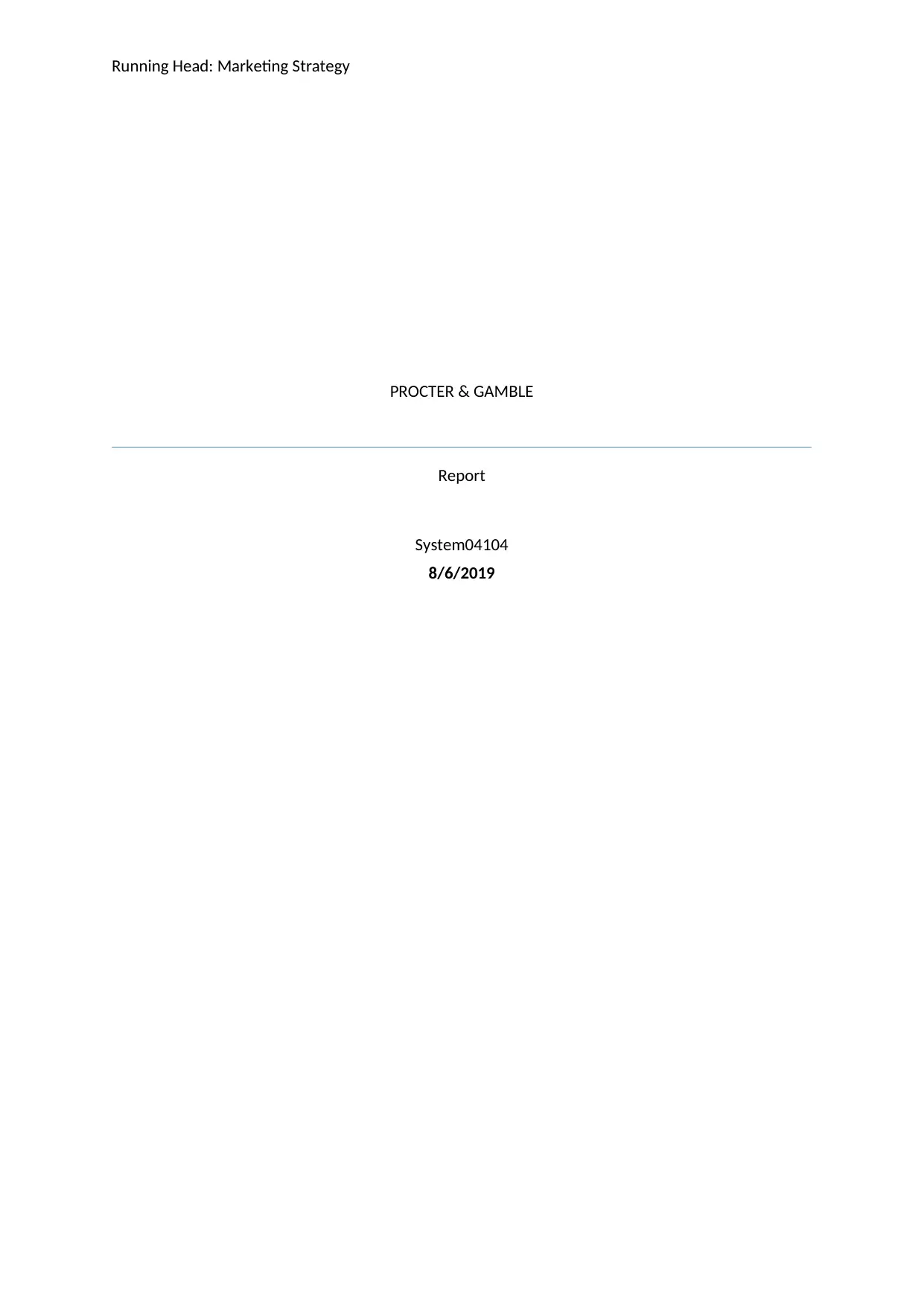
Running Head: Marketing Strategy
PROCTER & GAMBLE
Report
System04104
8/6/2019
PROCTER & GAMBLE
Report
System04104
8/6/2019
Paraphrase This Document
Need a fresh take? Get an instant paraphrase of this document with our AI Paraphraser
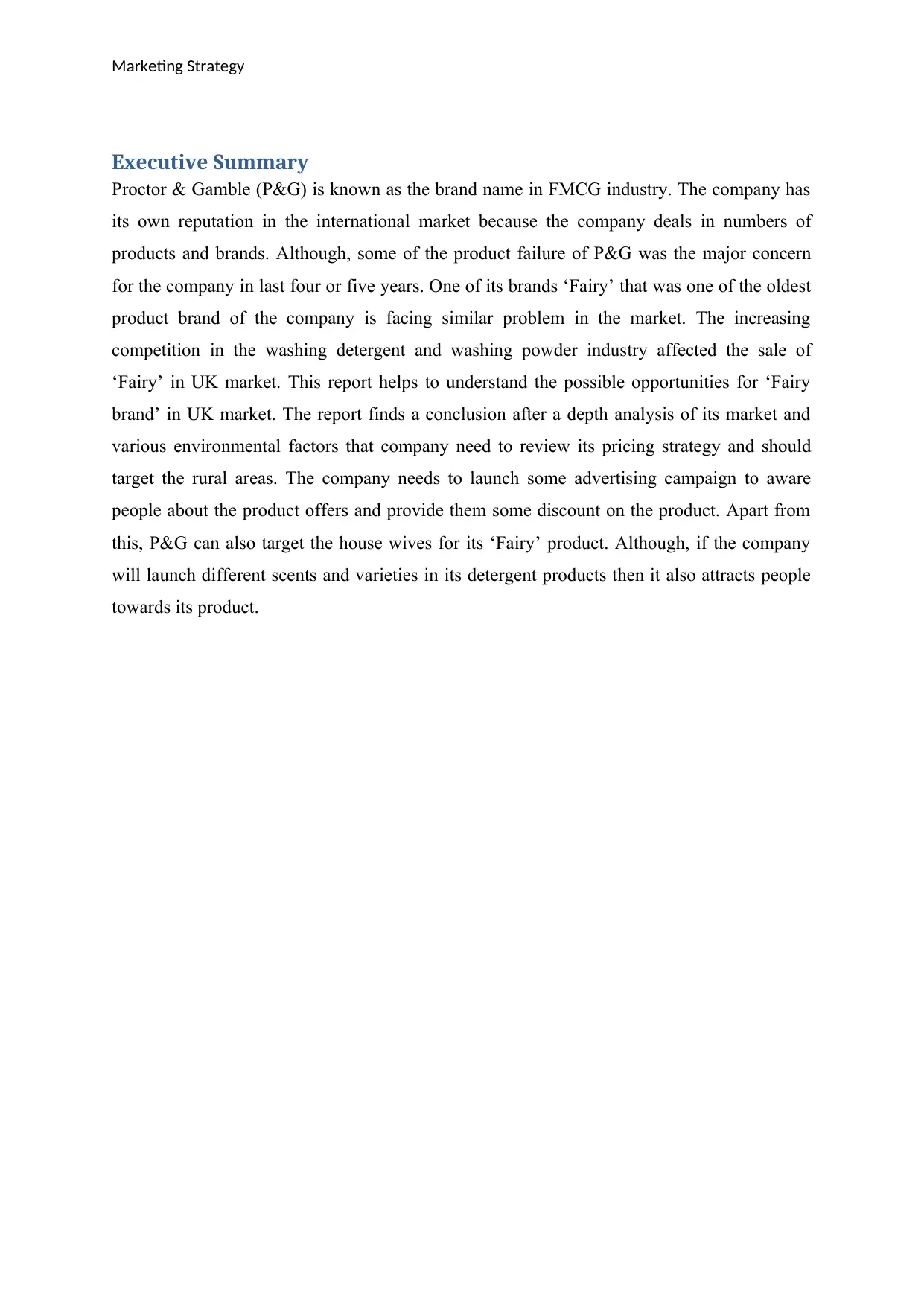
Marketing Strategy
Executive Summary
Proctor & Gamble (P&G) is known as the brand name in FMCG industry. The company has
its own reputation in the international market because the company deals in numbers of
products and brands. Although, some of the product failure of P&G was the major concern
for the company in last four or five years. One of its brands ‘Fairy’ that was one of the oldest
product brand of the company is facing similar problem in the market. The increasing
competition in the washing detergent and washing powder industry affected the sale of
‘Fairy’ in UK market. This report helps to understand the possible opportunities for ‘Fairy
brand’ in UK market. The report finds a conclusion after a depth analysis of its market and
various environmental factors that company need to review its pricing strategy and should
target the rural areas. The company needs to launch some advertising campaign to aware
people about the product offers and provide them some discount on the product. Apart from
this, P&G can also target the house wives for its ‘Fairy’ product. Although, if the company
will launch different scents and varieties in its detergent products then it also attracts people
towards its product.
Executive Summary
Proctor & Gamble (P&G) is known as the brand name in FMCG industry. The company has
its own reputation in the international market because the company deals in numbers of
products and brands. Although, some of the product failure of P&G was the major concern
for the company in last four or five years. One of its brands ‘Fairy’ that was one of the oldest
product brand of the company is facing similar problem in the market. The increasing
competition in the washing detergent and washing powder industry affected the sale of
‘Fairy’ in UK market. This report helps to understand the possible opportunities for ‘Fairy
brand’ in UK market. The report finds a conclusion after a depth analysis of its market and
various environmental factors that company need to review its pricing strategy and should
target the rural areas. The company needs to launch some advertising campaign to aware
people about the product offers and provide them some discount on the product. Apart from
this, P&G can also target the house wives for its ‘Fairy’ product. Although, if the company
will launch different scents and varieties in its detergent products then it also attracts people
towards its product.
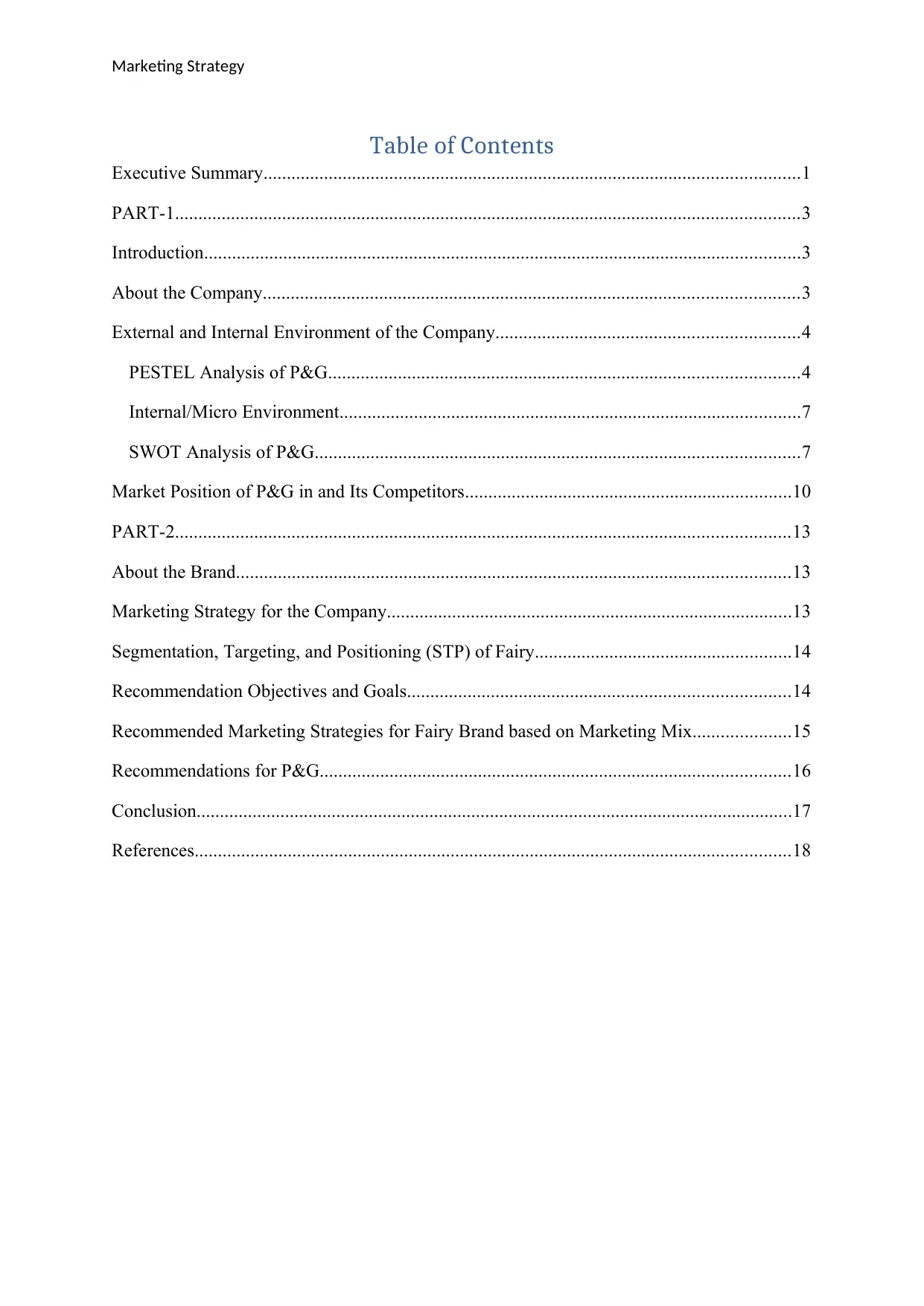
Marketing Strategy
Table of Contents
Executive Summary...................................................................................................................1
PART-1......................................................................................................................................3
Introduction................................................................................................................................3
About the Company...................................................................................................................3
External and Internal Environment of the Company.................................................................4
PESTEL Analysis of P&G.....................................................................................................4
Internal/Micro Environment...................................................................................................7
SWOT Analysis of P&G........................................................................................................7
Market Position of P&G in and Its Competitors......................................................................10
PART-2....................................................................................................................................13
About the Brand.......................................................................................................................13
Marketing Strategy for the Company.......................................................................................13
Segmentation, Targeting, and Positioning (STP) of Fairy.......................................................14
Recommendation Objectives and Goals..................................................................................14
Recommended Marketing Strategies for Fairy Brand based on Marketing Mix.....................15
Recommendations for P&G.....................................................................................................16
Conclusion................................................................................................................................17
References................................................................................................................................18
Table of Contents
Executive Summary...................................................................................................................1
PART-1......................................................................................................................................3
Introduction................................................................................................................................3
About the Company...................................................................................................................3
External and Internal Environment of the Company.................................................................4
PESTEL Analysis of P&G.....................................................................................................4
Internal/Micro Environment...................................................................................................7
SWOT Analysis of P&G........................................................................................................7
Market Position of P&G in and Its Competitors......................................................................10
PART-2....................................................................................................................................13
About the Brand.......................................................................................................................13
Marketing Strategy for the Company.......................................................................................13
Segmentation, Targeting, and Positioning (STP) of Fairy.......................................................14
Recommendation Objectives and Goals..................................................................................14
Recommended Marketing Strategies for Fairy Brand based on Marketing Mix.....................15
Recommendations for P&G.....................................................................................................16
Conclusion................................................................................................................................17
References................................................................................................................................18
⊘ This is a preview!⊘
Do you want full access?
Subscribe today to unlock all pages.

Trusted by 1+ million students worldwide
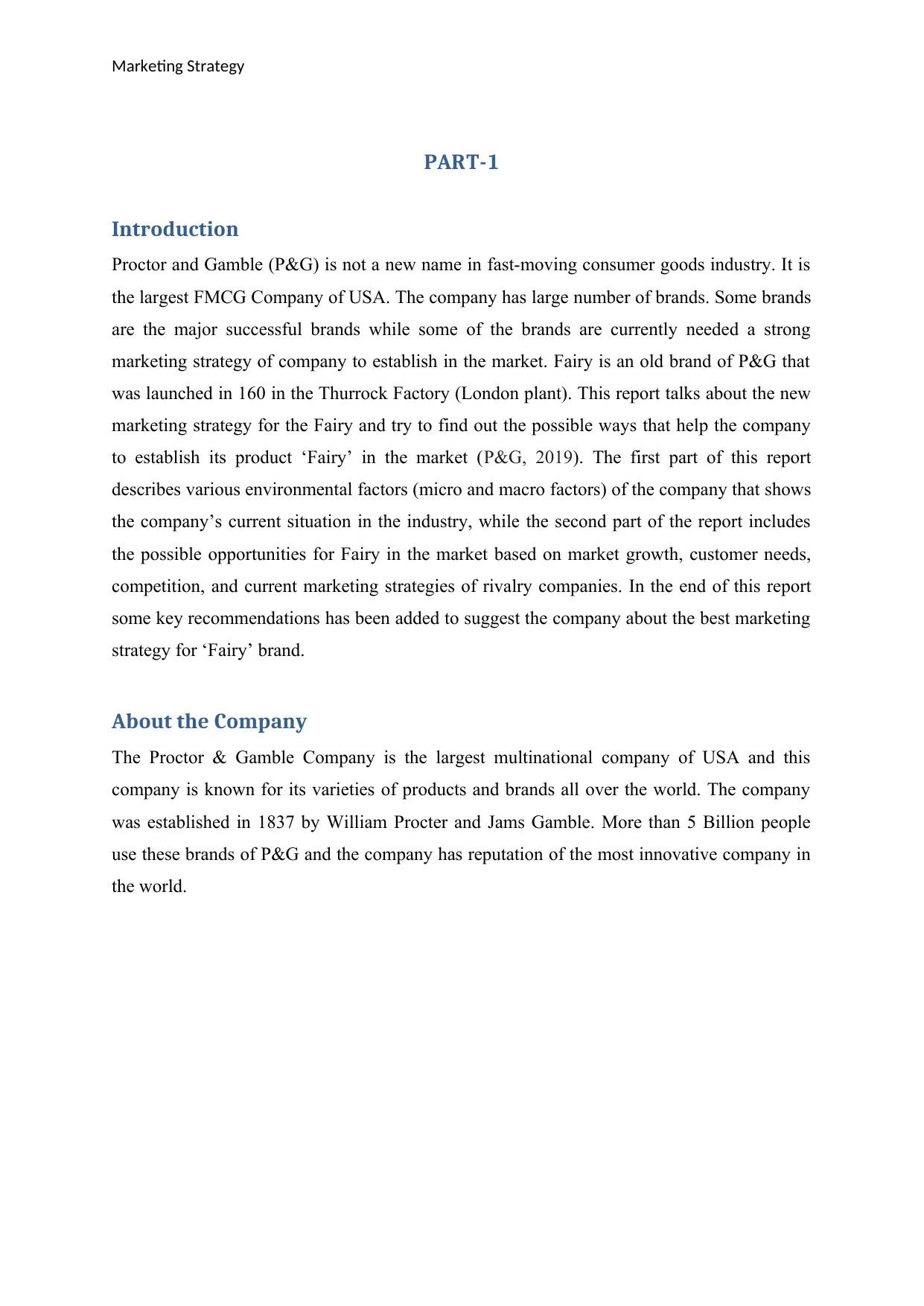
Marketing Strategy
PART-1
Introduction
Proctor and Gamble (P&G) is not a new name in fast-moving consumer goods industry. It is
the largest FMCG Company of USA. The company has large number of brands. Some brands
are the major successful brands while some of the brands are currently needed a strong
marketing strategy of company to establish in the market. Fairy is an old brand of P&G that
was launched in 160 in the Thurrock Factory (London plant). This report talks about the new
marketing strategy for the Fairy and try to find out the possible ways that help the company
to establish its product ‘Fairy’ in the market (P&G, 2019). The first part of this report
describes various environmental factors (micro and macro factors) of the company that shows
the company’s current situation in the industry, while the second part of the report includes
the possible opportunities for Fairy in the market based on market growth, customer needs,
competition, and current marketing strategies of rivalry companies. In the end of this report
some key recommendations has been added to suggest the company about the best marketing
strategy for ‘Fairy’ brand.
About the Company
The Proctor & Gamble Company is the largest multinational company of USA and this
company is known for its varieties of products and brands all over the world. The company
was established in 1837 by William Procter and Jams Gamble. More than 5 Billion people
use these brands of P&G and the company has reputation of the most innovative company in
the world.
PART-1
Introduction
Proctor and Gamble (P&G) is not a new name in fast-moving consumer goods industry. It is
the largest FMCG Company of USA. The company has large number of brands. Some brands
are the major successful brands while some of the brands are currently needed a strong
marketing strategy of company to establish in the market. Fairy is an old brand of P&G that
was launched in 160 in the Thurrock Factory (London plant). This report talks about the new
marketing strategy for the Fairy and try to find out the possible ways that help the company
to establish its product ‘Fairy’ in the market (P&G, 2019). The first part of this report
describes various environmental factors (micro and macro factors) of the company that shows
the company’s current situation in the industry, while the second part of the report includes
the possible opportunities for Fairy in the market based on market growth, customer needs,
competition, and current marketing strategies of rivalry companies. In the end of this report
some key recommendations has been added to suggest the company about the best marketing
strategy for ‘Fairy’ brand.
About the Company
The Proctor & Gamble Company is the largest multinational company of USA and this
company is known for its varieties of products and brands all over the world. The company
was established in 1837 by William Procter and Jams Gamble. More than 5 Billion people
use these brands of P&G and the company has reputation of the most innovative company in
the world.
Paraphrase This Document
Need a fresh take? Get an instant paraphrase of this document with our AI Paraphraser
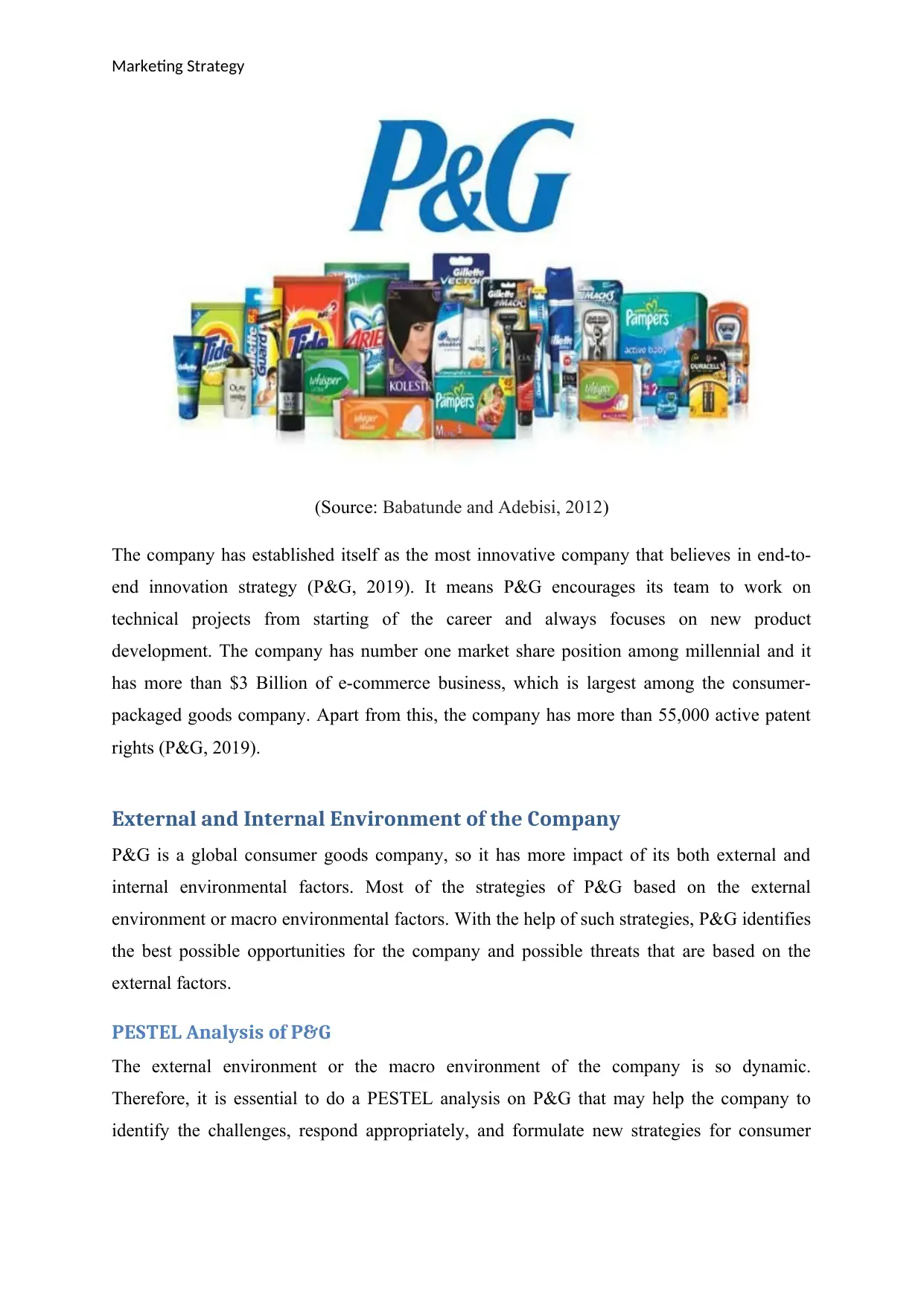
Marketing Strategy
(Source: Babatunde and Adebisi, 2012)
The company has established itself as the most innovative company that believes in end-to-
end innovation strategy (P&G, 2019). It means P&G encourages its team to work on
technical projects from starting of the career and always focuses on new product
development. The company has number one market share position among millennial and it
has more than $3 Billion of e-commerce business, which is largest among the consumer-
packaged goods company. Apart from this, the company has more than 55,000 active patent
rights (P&G, 2019).
External and Internal Environment of the Company
P&G is a global consumer goods company, so it has more impact of its both external and
internal environmental factors. Most of the strategies of P&G based on the external
environment or macro environmental factors. With the help of such strategies, P&G identifies
the best possible opportunities for the company and possible threats that are based on the
external factors.
PESTEL Analysis of P&G
The external environment or the macro environment of the company is so dynamic.
Therefore, it is essential to do a PESTEL analysis on P&G that may help the company to
identify the challenges, respond appropriately, and formulate new strategies for consumer
(Source: Babatunde and Adebisi, 2012)
The company has established itself as the most innovative company that believes in end-to-
end innovation strategy (P&G, 2019). It means P&G encourages its team to work on
technical projects from starting of the career and always focuses on new product
development. The company has number one market share position among millennial and it
has more than $3 Billion of e-commerce business, which is largest among the consumer-
packaged goods company. Apart from this, the company has more than 55,000 active patent
rights (P&G, 2019).
External and Internal Environment of the Company
P&G is a global consumer goods company, so it has more impact of its both external and
internal environmental factors. Most of the strategies of P&G based on the external
environment or macro environmental factors. With the help of such strategies, P&G identifies
the best possible opportunities for the company and possible threats that are based on the
external factors.
PESTEL Analysis of P&G
The external environment or the macro environment of the company is so dynamic.
Therefore, it is essential to do a PESTEL analysis on P&G that may help the company to
identify the challenges, respond appropriately, and formulate new strategies for consumer
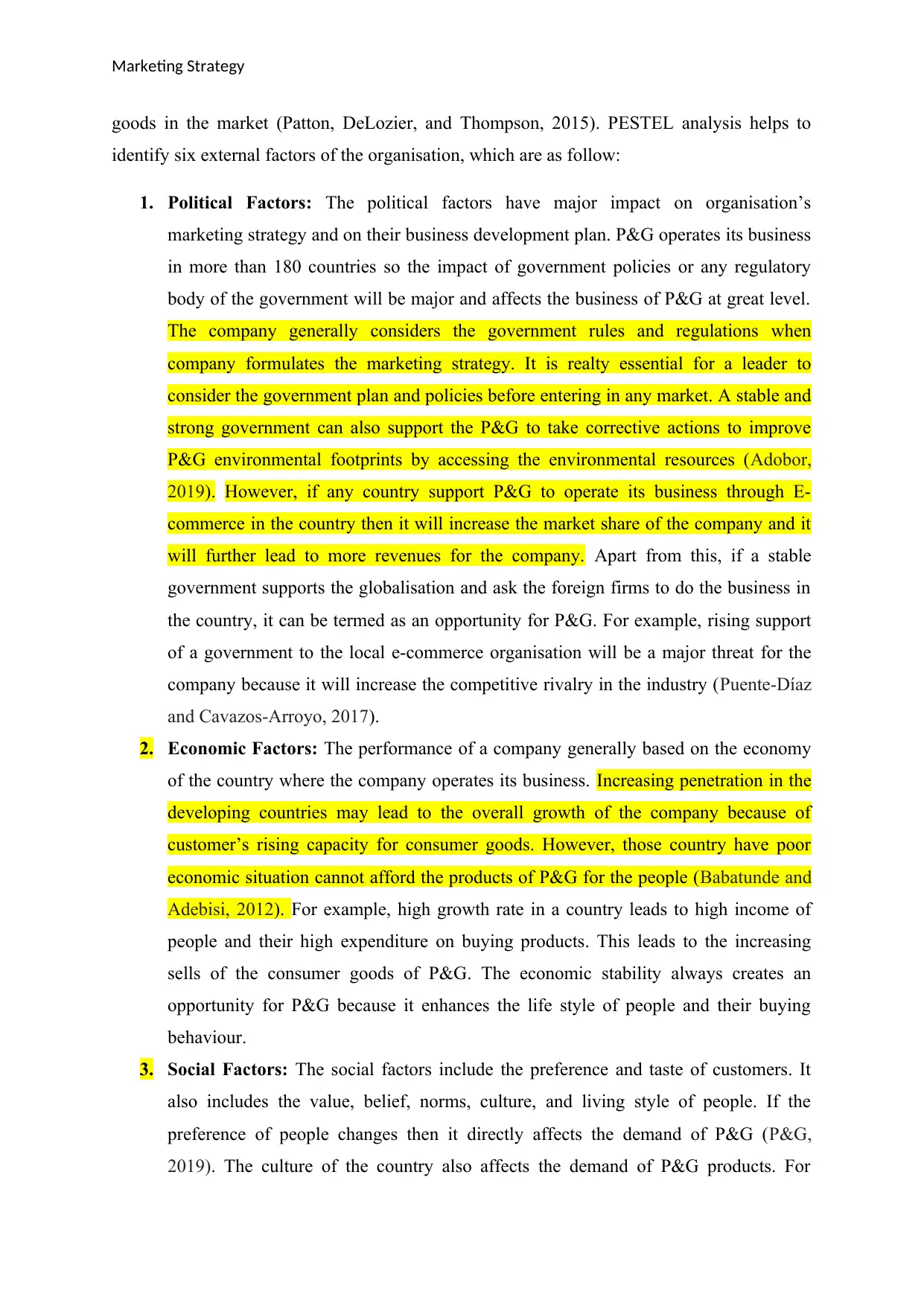
Marketing Strategy
goods in the market (Patton, DeLozier, and Thompson, 2015). PESTEL analysis helps to
identify six external factors of the organisation, which are as follow:
1. Political Factors: The political factors have major impact on organisation’s
marketing strategy and on their business development plan. P&G operates its business
in more than 180 countries so the impact of government policies or any regulatory
body of the government will be major and affects the business of P&G at great level.
The company generally considers the government rules and regulations when
company formulates the marketing strategy. It is realty essential for a leader to
consider the government plan and policies before entering in any market. A stable and
strong government can also support the P&G to take corrective actions to improve
P&G environmental footprints by accessing the environmental resources (Adobor,
2019). However, if any country support P&G to operate its business through E-
commerce in the country then it will increase the market share of the company and it
will further lead to more revenues for the company. Apart from this, if a stable
government supports the globalisation and ask the foreign firms to do the business in
the country, it can be termed as an opportunity for P&G. For example, rising support
of a government to the local e-commerce organisation will be a major threat for the
company because it will increase the competitive rivalry in the industry (Puente‐Díaz
and Cavazos‐Arroyo, 2017).
2. Economic Factors: The performance of a company generally based on the economy
of the country where the company operates its business. Increasing penetration in the
developing countries may lead to the overall growth of the company because of
customer’s rising capacity for consumer goods. However, those country have poor
economic situation cannot afford the products of P&G for the people (Babatunde and
Adebisi, 2012). For example, high growth rate in a country leads to high income of
people and their high expenditure on buying products. This leads to the increasing
sells of the consumer goods of P&G. The economic stability always creates an
opportunity for P&G because it enhances the life style of people and their buying
behaviour.
3. Social Factors: The social factors include the preference and taste of customers. It
also includes the value, belief, norms, culture, and living style of people. If the
preference of people changes then it directly affects the demand of P&G (P&G,
2019). The culture of the country also affects the demand of P&G products. For
goods in the market (Patton, DeLozier, and Thompson, 2015). PESTEL analysis helps to
identify six external factors of the organisation, which are as follow:
1. Political Factors: The political factors have major impact on organisation’s
marketing strategy and on their business development plan. P&G operates its business
in more than 180 countries so the impact of government policies or any regulatory
body of the government will be major and affects the business of P&G at great level.
The company generally considers the government rules and regulations when
company formulates the marketing strategy. It is realty essential for a leader to
consider the government plan and policies before entering in any market. A stable and
strong government can also support the P&G to take corrective actions to improve
P&G environmental footprints by accessing the environmental resources (Adobor,
2019). However, if any country support P&G to operate its business through E-
commerce in the country then it will increase the market share of the company and it
will further lead to more revenues for the company. Apart from this, if a stable
government supports the globalisation and ask the foreign firms to do the business in
the country, it can be termed as an opportunity for P&G. For example, rising support
of a government to the local e-commerce organisation will be a major threat for the
company because it will increase the competitive rivalry in the industry (Puente‐Díaz
and Cavazos‐Arroyo, 2017).
2. Economic Factors: The performance of a company generally based on the economy
of the country where the company operates its business. Increasing penetration in the
developing countries may lead to the overall growth of the company because of
customer’s rising capacity for consumer goods. However, those country have poor
economic situation cannot afford the products of P&G for the people (Babatunde and
Adebisi, 2012). For example, high growth rate in a country leads to high income of
people and their high expenditure on buying products. This leads to the increasing
sells of the consumer goods of P&G. The economic stability always creates an
opportunity for P&G because it enhances the life style of people and their buying
behaviour.
3. Social Factors: The social factors include the preference and taste of customers. It
also includes the value, belief, norms, culture, and living style of people. If the
preference of people changes then it directly affects the demand of P&G (P&G,
2019). The culture of the country also affects the demand of P&G products. For
⊘ This is a preview!⊘
Do you want full access?
Subscribe today to unlock all pages.

Trusted by 1+ million students worldwide
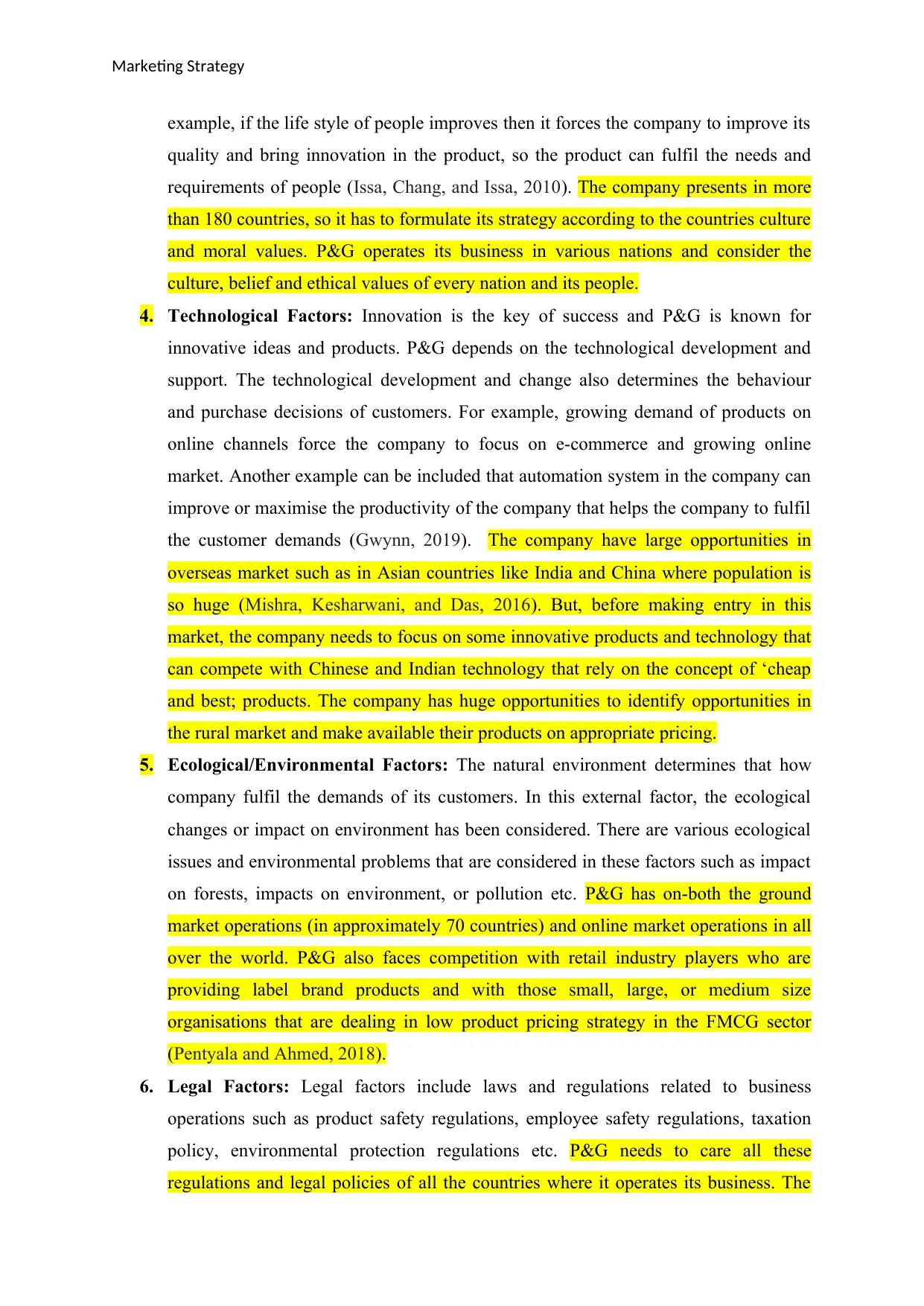
Marketing Strategy
example, if the life style of people improves then it forces the company to improve its
quality and bring innovation in the product, so the product can fulfil the needs and
requirements of people (Issa, Chang, and Issa, 2010). The company presents in more
than 180 countries, so it has to formulate its strategy according to the countries culture
and moral values. P&G operates its business in various nations and consider the
culture, belief and ethical values of every nation and its people.
4. Technological Factors: Innovation is the key of success and P&G is known for
innovative ideas and products. P&G depends on the technological development and
support. The technological development and change also determines the behaviour
and purchase decisions of customers. For example, growing demand of products on
online channels force the company to focus on e-commerce and growing online
market. Another example can be included that automation system in the company can
improve or maximise the productivity of the company that helps the company to fulfil
the customer demands (Gwynn, 2019). The company have large opportunities in
overseas market such as in Asian countries like India and China where population is
so huge (Mishra, Kesharwani, and Das, 2016). But, before making entry in this
market, the company needs to focus on some innovative products and technology that
can compete with Chinese and Indian technology that rely on the concept of ‘cheap
and best; products. The company has huge opportunities to identify opportunities in
the rural market and make available their products on appropriate pricing.
5. Ecological/Environmental Factors: The natural environment determines that how
company fulfil the demands of its customers. In this external factor, the ecological
changes or impact on environment has been considered. There are various ecological
issues and environmental problems that are considered in these factors such as impact
on forests, impacts on environment, or pollution etc. P&G has on-both the ground
market operations (in approximately 70 countries) and online market operations in all
over the world. P&G also faces competition with retail industry players who are
providing label brand products and with those small, large, or medium size
organisations that are dealing in low product pricing strategy in the FMCG sector
(Pentyala and Ahmed, 2018).
6. Legal Factors: Legal factors include laws and regulations related to business
operations such as product safety regulations, employee safety regulations, taxation
policy, environmental protection regulations etc. P&G needs to care all these
regulations and legal policies of all the countries where it operates its business. The
example, if the life style of people improves then it forces the company to improve its
quality and bring innovation in the product, so the product can fulfil the needs and
requirements of people (Issa, Chang, and Issa, 2010). The company presents in more
than 180 countries, so it has to formulate its strategy according to the countries culture
and moral values. P&G operates its business in various nations and consider the
culture, belief and ethical values of every nation and its people.
4. Technological Factors: Innovation is the key of success and P&G is known for
innovative ideas and products. P&G depends on the technological development and
support. The technological development and change also determines the behaviour
and purchase decisions of customers. For example, growing demand of products on
online channels force the company to focus on e-commerce and growing online
market. Another example can be included that automation system in the company can
improve or maximise the productivity of the company that helps the company to fulfil
the customer demands (Gwynn, 2019). The company have large opportunities in
overseas market such as in Asian countries like India and China where population is
so huge (Mishra, Kesharwani, and Das, 2016). But, before making entry in this
market, the company needs to focus on some innovative products and technology that
can compete with Chinese and Indian technology that rely on the concept of ‘cheap
and best; products. The company has huge opportunities to identify opportunities in
the rural market and make available their products on appropriate pricing.
5. Ecological/Environmental Factors: The natural environment determines that how
company fulfil the demands of its customers. In this external factor, the ecological
changes or impact on environment has been considered. There are various ecological
issues and environmental problems that are considered in these factors such as impact
on forests, impacts on environment, or pollution etc. P&G has on-both the ground
market operations (in approximately 70 countries) and online market operations in all
over the world. P&G also faces competition with retail industry players who are
providing label brand products and with those small, large, or medium size
organisations that are dealing in low product pricing strategy in the FMCG sector
(Pentyala and Ahmed, 2018).
6. Legal Factors: Legal factors include laws and regulations related to business
operations such as product safety regulations, employee safety regulations, taxation
policy, environmental protection regulations etc. P&G needs to care all these
regulations and legal policies of all the countries where it operates its business. The
Paraphrase This Document
Need a fresh take? Get an instant paraphrase of this document with our AI Paraphraser
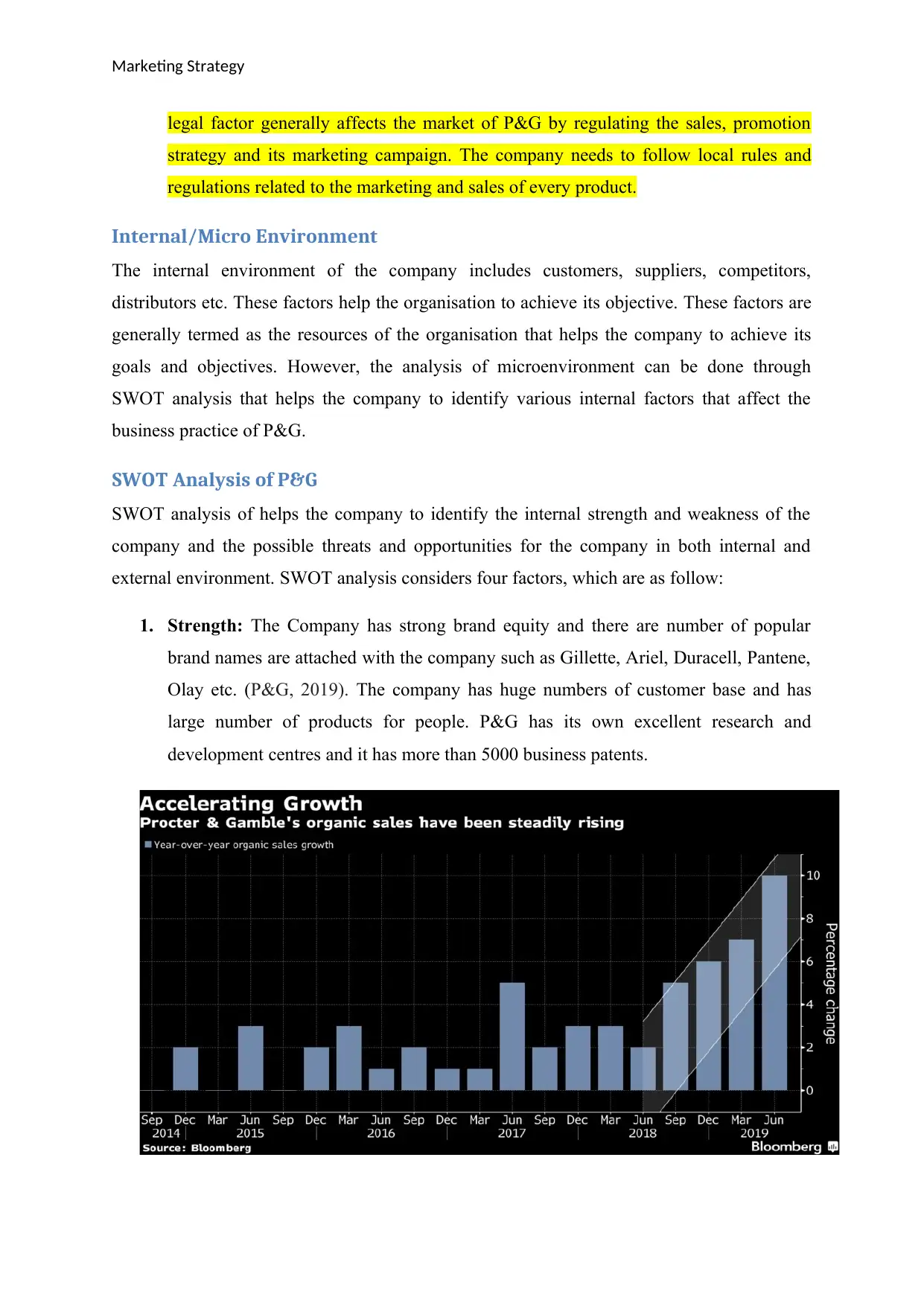
Marketing Strategy
legal factor generally affects the market of P&G by regulating the sales, promotion
strategy and its marketing campaign. The company needs to follow local rules and
regulations related to the marketing and sales of every product.
Internal/Micro Environment
The internal environment of the company includes customers, suppliers, competitors,
distributors etc. These factors help the organisation to achieve its objective. These factors are
generally termed as the resources of the organisation that helps the company to achieve its
goals and objectives. However, the analysis of microenvironment can be done through
SWOT analysis that helps the company to identify various internal factors that affect the
business practice of P&G.
SWOT Analysis of P&G
SWOT analysis of helps the company to identify the internal strength and weakness of the
company and the possible threats and opportunities for the company in both internal and
external environment. SWOT analysis considers four factors, which are as follow:
1. Strength: The Company has strong brand equity and there are number of popular
brand names are attached with the company such as Gillette, Ariel, Duracell, Pantene,
Olay etc. (P&G, 2019). The company has huge numbers of customer base and has
large number of products for people. P&G has its own excellent research and
development centres and it has more than 5000 business patents.
legal factor generally affects the market of P&G by regulating the sales, promotion
strategy and its marketing campaign. The company needs to follow local rules and
regulations related to the marketing and sales of every product.
Internal/Micro Environment
The internal environment of the company includes customers, suppliers, competitors,
distributors etc. These factors help the organisation to achieve its objective. These factors are
generally termed as the resources of the organisation that helps the company to achieve its
goals and objectives. However, the analysis of microenvironment can be done through
SWOT analysis that helps the company to identify various internal factors that affect the
business practice of P&G.
SWOT Analysis of P&G
SWOT analysis of helps the company to identify the internal strength and weakness of the
company and the possible threats and opportunities for the company in both internal and
external environment. SWOT analysis considers four factors, which are as follow:
1. Strength: The Company has strong brand equity and there are number of popular
brand names are attached with the company such as Gillette, Ariel, Duracell, Pantene,
Olay etc. (P&G, 2019). The company has huge numbers of customer base and has
large number of products for people. P&G has its own excellent research and
development centres and it has more than 5000 business patents.
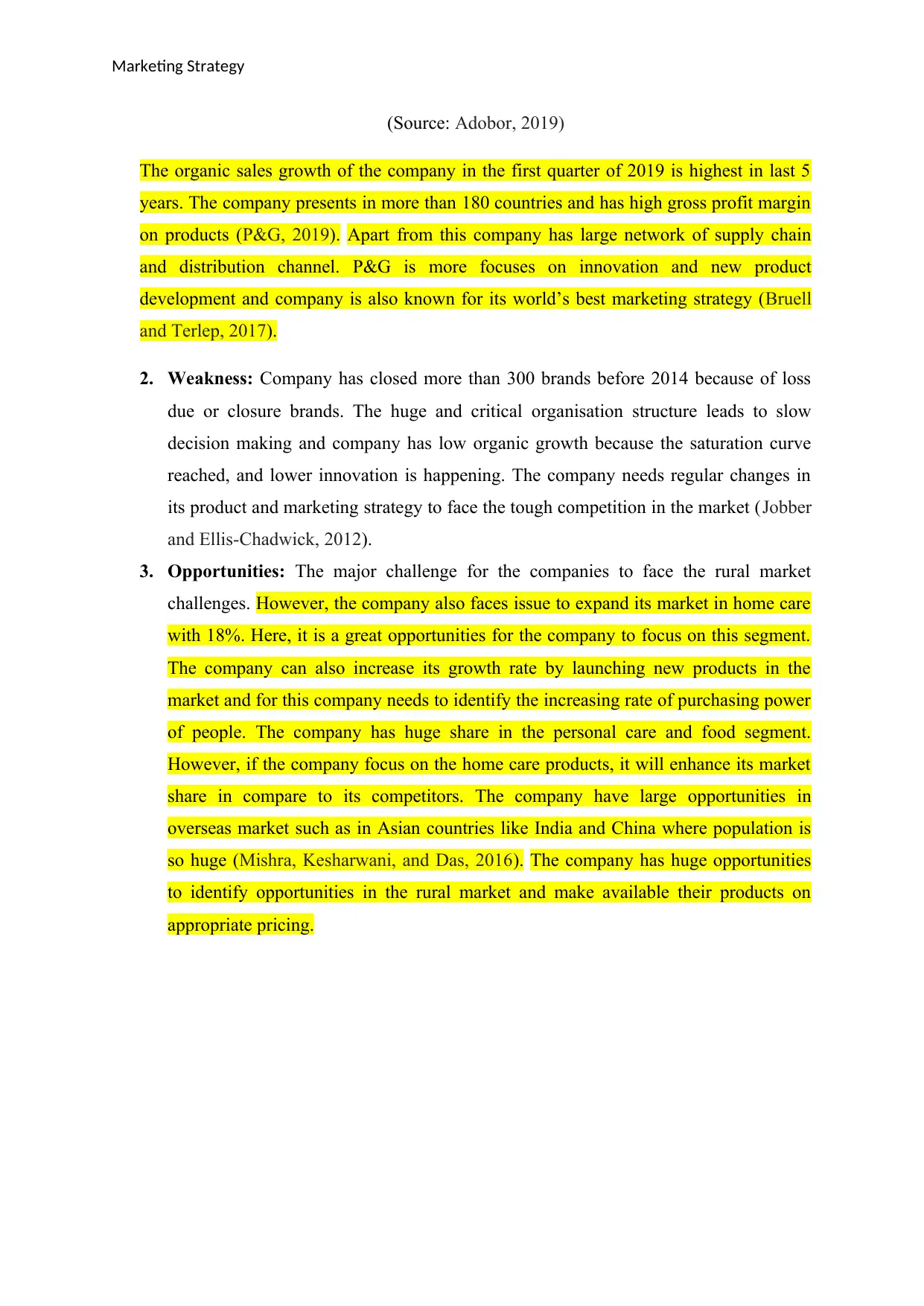
Marketing Strategy
(Source: Adobor, 2019)
The organic sales growth of the company in the first quarter of 2019 is highest in last 5
years. The company presents in more than 180 countries and has high gross profit margin
on products (P&G, 2019). Apart from this company has large network of supply chain
and distribution channel. P&G is more focuses on innovation and new product
development and company is also known for its world’s best marketing strategy (Bruell
and Terlep, 2017).
2. Weakness: Company has closed more than 300 brands before 2014 because of loss
due or closure brands. The huge and critical organisation structure leads to slow
decision making and company has low organic growth because the saturation curve
reached, and lower innovation is happening. The company needs regular changes in
its product and marketing strategy to face the tough competition in the market (Jobber
and Ellis-Chadwick, 2012).
3. Opportunities: The major challenge for the companies to face the rural market
challenges. However, the company also faces issue to expand its market in home care
with 18%. Here, it is a great opportunities for the company to focus on this segment.
The company can also increase its growth rate by launching new products in the
market and for this company needs to identify the increasing rate of purchasing power
of people. The company has huge share in the personal care and food segment.
However, if the company focus on the home care products, it will enhance its market
share in compare to its competitors. The company have large opportunities in
overseas market such as in Asian countries like India and China where population is
so huge (Mishra, Kesharwani, and Das, 2016). The company has huge opportunities
to identify opportunities in the rural market and make available their products on
appropriate pricing.
(Source: Adobor, 2019)
The organic sales growth of the company in the first quarter of 2019 is highest in last 5
years. The company presents in more than 180 countries and has high gross profit margin
on products (P&G, 2019). Apart from this company has large network of supply chain
and distribution channel. P&G is more focuses on innovation and new product
development and company is also known for its world’s best marketing strategy (Bruell
and Terlep, 2017).
2. Weakness: Company has closed more than 300 brands before 2014 because of loss
due or closure brands. The huge and critical organisation structure leads to slow
decision making and company has low organic growth because the saturation curve
reached, and lower innovation is happening. The company needs regular changes in
its product and marketing strategy to face the tough competition in the market (Jobber
and Ellis-Chadwick, 2012).
3. Opportunities: The major challenge for the companies to face the rural market
challenges. However, the company also faces issue to expand its market in home care
with 18%. Here, it is a great opportunities for the company to focus on this segment.
The company can also increase its growth rate by launching new products in the
market and for this company needs to identify the increasing rate of purchasing power
of people. The company has huge share in the personal care and food segment.
However, if the company focus on the home care products, it will enhance its market
share in compare to its competitors. The company have large opportunities in
overseas market such as in Asian countries like India and China where population is
so huge (Mishra, Kesharwani, and Das, 2016). The company has huge opportunities
to identify opportunities in the rural market and make available their products on
appropriate pricing.
⊘ This is a preview!⊘
Do you want full access?
Subscribe today to unlock all pages.

Trusted by 1+ million students worldwide
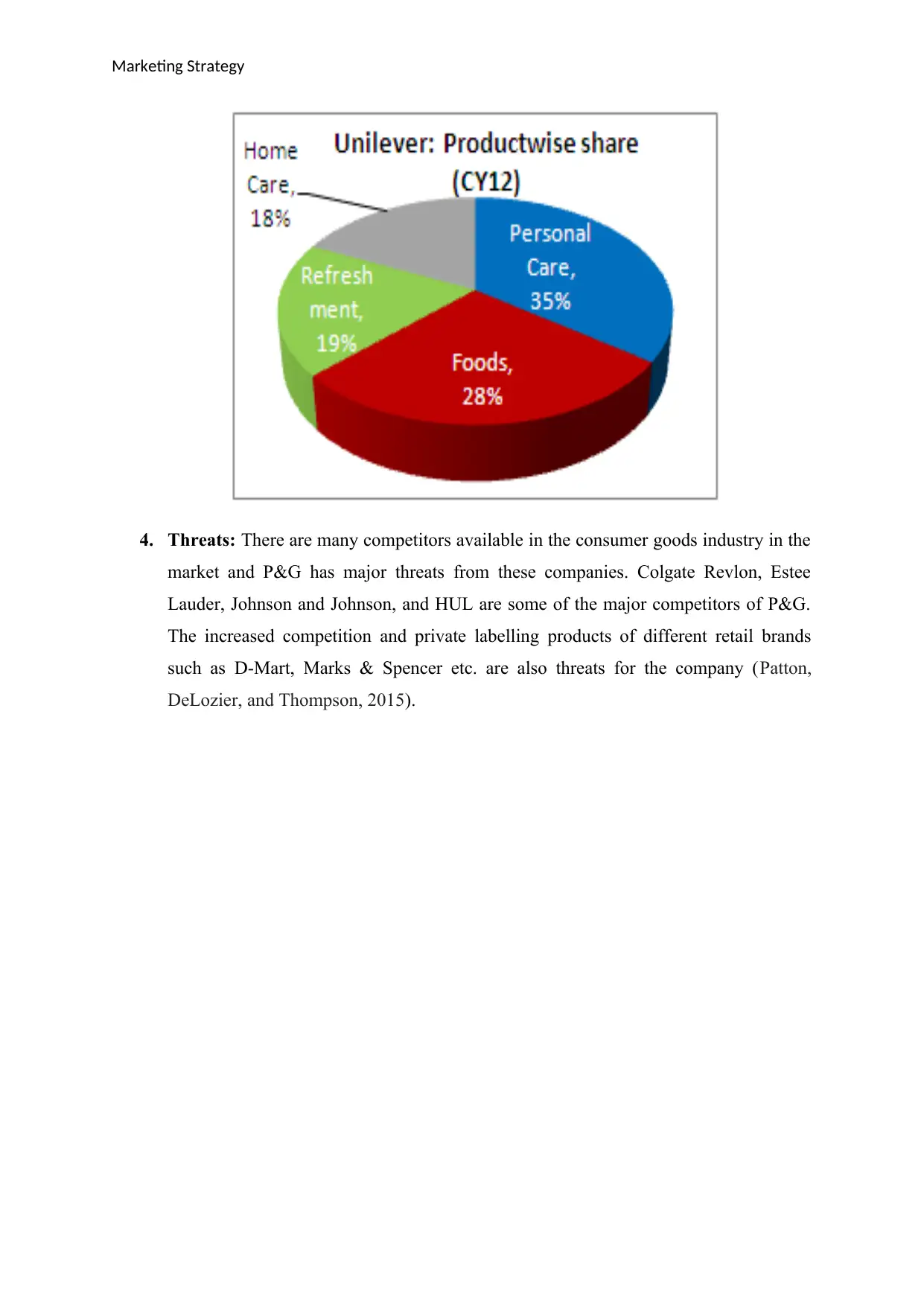
Marketing Strategy
4. Threats: There are many competitors available in the consumer goods industry in the
market and P&G has major threats from these companies. Colgate Revlon, Estee
Lauder, Johnson and Johnson, and HUL are some of the major competitors of P&G.
The increased competition and private labelling products of different retail brands
such as D-Mart, Marks & Spencer etc. are also threats for the company (Patton,
DeLozier, and Thompson, 2015).
4. Threats: There are many competitors available in the consumer goods industry in the
market and P&G has major threats from these companies. Colgate Revlon, Estee
Lauder, Johnson and Johnson, and HUL are some of the major competitors of P&G.
The increased competition and private labelling products of different retail brands
such as D-Mart, Marks & Spencer etc. are also threats for the company (Patton,
DeLozier, and Thompson, 2015).
Paraphrase This Document
Need a fresh take? Get an instant paraphrase of this document with our AI Paraphraser
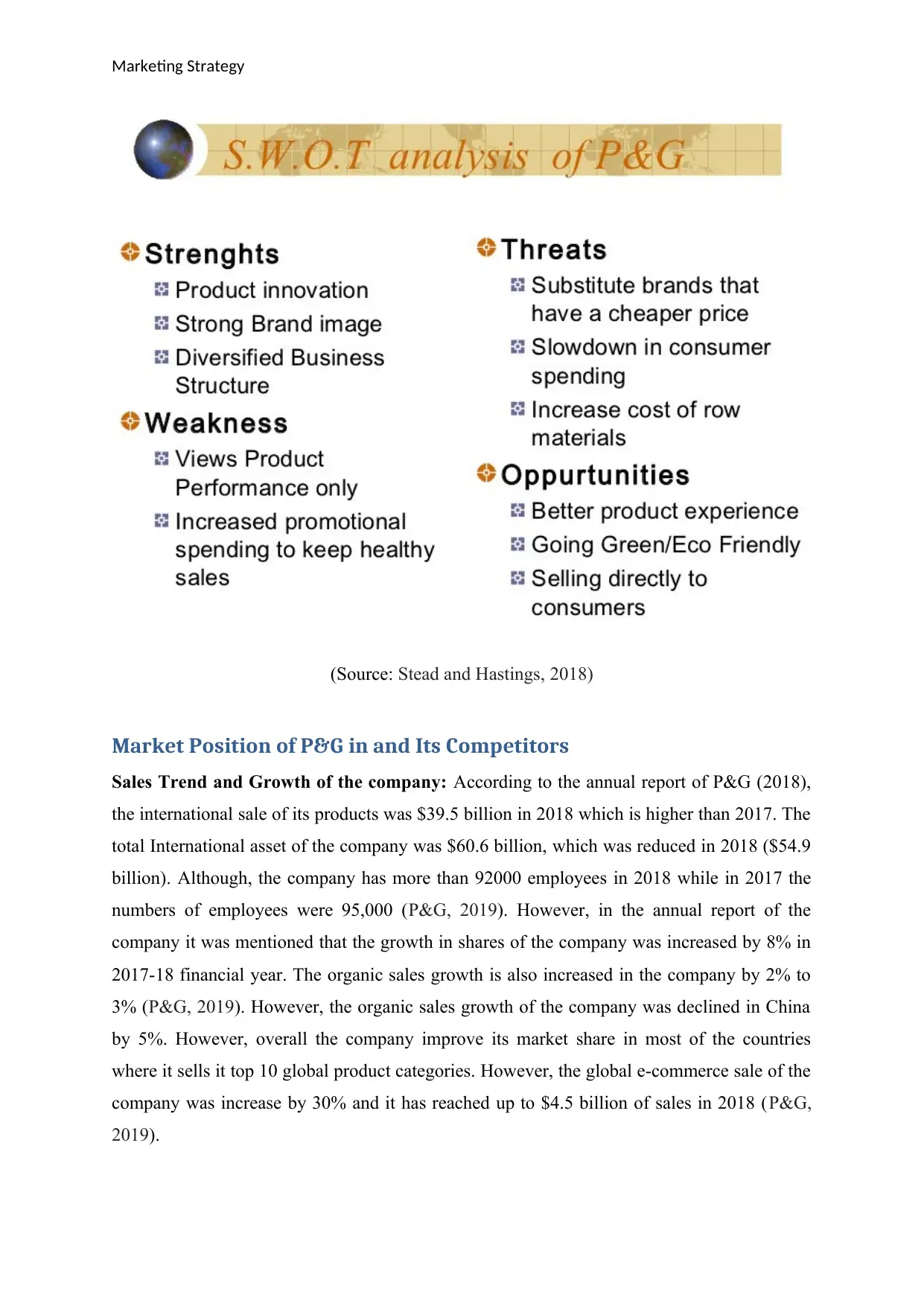
Marketing Strategy
(Source: Stead and Hastings, 2018)
Market Position of P&G in and Its Competitors
Sales Trend and Growth of the company: According to the annual report of P&G (2018),
the international sale of its products was $39.5 billion in 2018 which is higher than 2017. The
total International asset of the company was $60.6 billion, which was reduced in 2018 ($54.9
billion). Although, the company has more than 92000 employees in 2018 while in 2017 the
numbers of employees were 95,000 (P&G, 2019). However, in the annual report of the
company it was mentioned that the growth in shares of the company was increased by 8% in
2017-18 financial year. The organic sales growth is also increased in the company by 2% to
3% (P&G, 2019). However, the organic sales growth of the company was declined in China
by 5%. However, overall the company improve its market share in most of the countries
where it sells it top 10 global product categories. However, the global e-commerce sale of the
company was increase by 30% and it has reached up to $4.5 billion of sales in 2018 (P&G,
2019).
(Source: Stead and Hastings, 2018)
Market Position of P&G in and Its Competitors
Sales Trend and Growth of the company: According to the annual report of P&G (2018),
the international sale of its products was $39.5 billion in 2018 which is higher than 2017. The
total International asset of the company was $60.6 billion, which was reduced in 2018 ($54.9
billion). Although, the company has more than 92000 employees in 2018 while in 2017 the
numbers of employees were 95,000 (P&G, 2019). However, in the annual report of the
company it was mentioned that the growth in shares of the company was increased by 8% in
2017-18 financial year. The organic sales growth is also increased in the company by 2% to
3% (P&G, 2019). However, the organic sales growth of the company was declined in China
by 5%. However, overall the company improve its market share in most of the countries
where it sells it top 10 global product categories. However, the global e-commerce sale of the
company was increase by 30% and it has reached up to $4.5 billion of sales in 2018 (P&G,
2019).
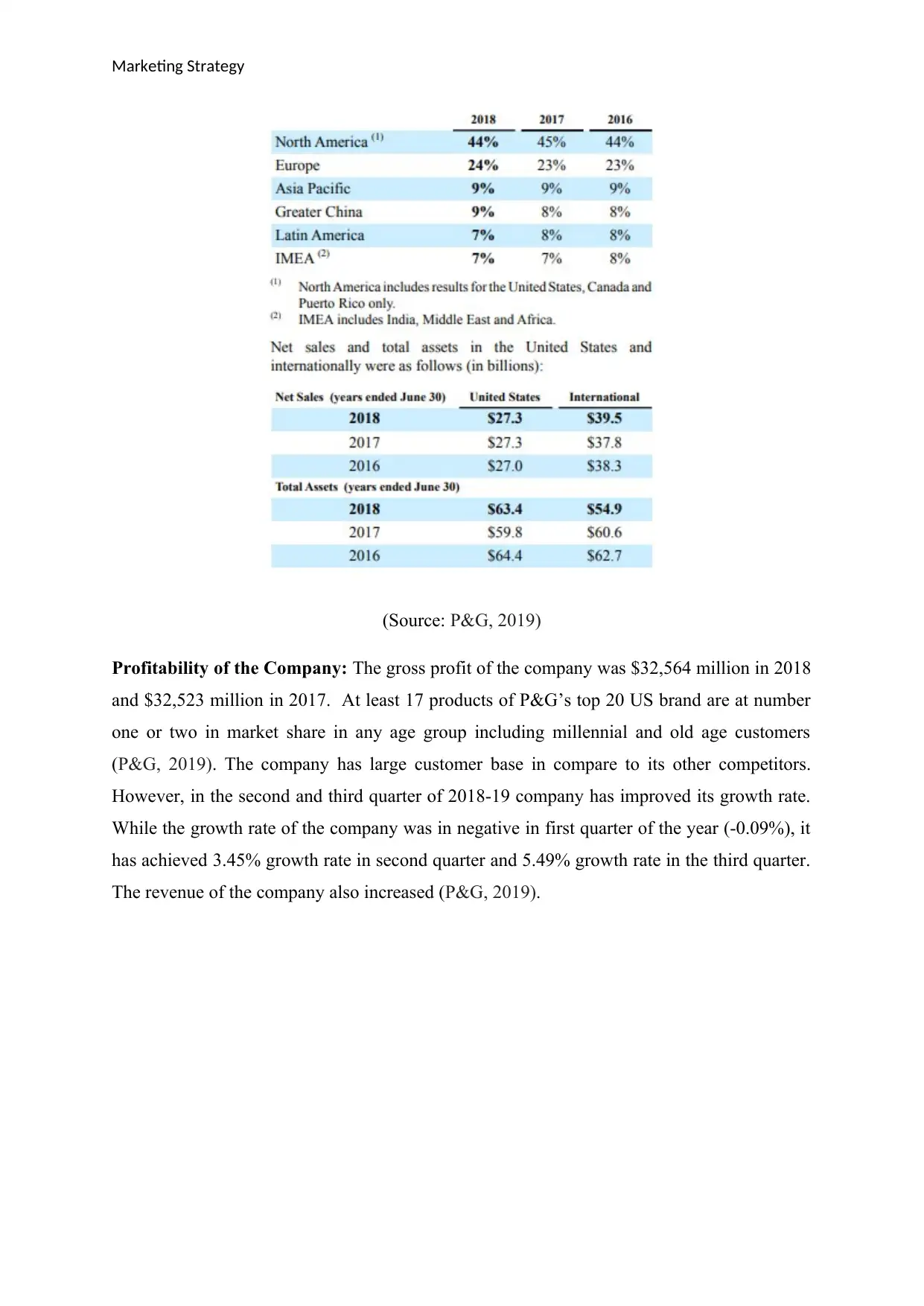
Marketing Strategy
(Source: P&G, 2019)
Profitability of the Company: The gross profit of the company was $32,564 million in 2018
and $32,523 million in 2017. At least 17 products of P&G’s top 20 US brand are at number
one or two in market share in any age group including millennial and old age customers
(P&G, 2019). The company has large customer base in compare to its other competitors.
However, in the second and third quarter of 2018-19 company has improved its growth rate.
While the growth rate of the company was in negative in first quarter of the year (-0.09%), it
has achieved 3.45% growth rate in second quarter and 5.49% growth rate in the third quarter.
The revenue of the company also increased (P&G, 2019).
(Source: P&G, 2019)
Profitability of the Company: The gross profit of the company was $32,564 million in 2018
and $32,523 million in 2017. At least 17 products of P&G’s top 20 US brand are at number
one or two in market share in any age group including millennial and old age customers
(P&G, 2019). The company has large customer base in compare to its other competitors.
However, in the second and third quarter of 2018-19 company has improved its growth rate.
While the growth rate of the company was in negative in first quarter of the year (-0.09%), it
has achieved 3.45% growth rate in second quarter and 5.49% growth rate in the third quarter.
The revenue of the company also increased (P&G, 2019).
⊘ This is a preview!⊘
Do you want full access?
Subscribe today to unlock all pages.

Trusted by 1+ million students worldwide
1 out of 21
Related Documents
Your All-in-One AI-Powered Toolkit for Academic Success.
+13062052269
info@desklib.com
Available 24*7 on WhatsApp / Email
![[object Object]](/_next/static/media/star-bottom.7253800d.svg)
Unlock your academic potential
Copyright © 2020–2025 A2Z Services. All Rights Reserved. Developed and managed by ZUCOL.




